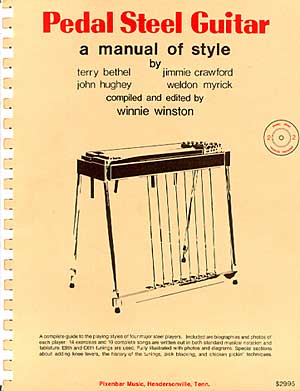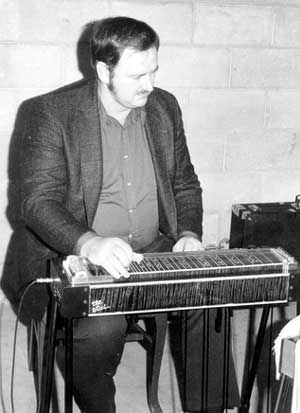 The Manual of Style
The Manual of Style The Manual of Style
The Manual of StyleAfter I finished the Oak book, I began to think about doing a follow up. I had this as the idea:
I'd get together with about ten steel players in Nashville. (Want to guess which ones?) We'd have a single rhythm track laid down, and each of them would play one go around. Then we'd tab out what they did, and discuss their individual styles, leaving room for them to tab out some of their better known "licks."
I made the proposal to Oak, but they said it would be too expensive, and turned it down.
 |
|---|
Sometime in the summer of 1976 I had a chance to talk about steels in depth with Jimmie Crawford when he was playing a show at Gloryland Park in Delaware with Kitty Wells and I was playing steel with the band that was opening the show.
In the spring of 1979 I received a phone call from Jimmie saying he was thinking about doing an instructional course, he had a few ideas, he was looking at my Pedal Steel Guitar book and he wanted to talk to me. Could I come down? The next weekend I flew to Nashville.
It turns out that Jimmie's idea and my idea were very similar. We discussed who we would like to involve in the project. We approached Lloyd Green but he was busy at the time. Both Terry Bethel and John Hughey were eager to get involved. After tossing around ideas about a fourth person, we asked Weldon Myrick. He came by Jimmie's house at about 1 a.m. after finishing up the Opry. We told him about the idea, and he couldn't believe that his playing was that highly treasured. We convinced him it was. We now had the people who would do the book.
 |
|---|
Jimmie had also conceived of a new tablature system which he called "Mu-Sym-Tab." It relied on using regular musical notation (sharp, double sharp, flat, double flat, and neutral) to show which strings were moving. It was something I wished I had done when I did the Oak book. It was brilliant.
And so, the project started. I'm not sure how many trips I made to Nashville, but it was probably four or five. On one trip I interviewed all the players , took pictures of them, and took pictures of their playing hands to show how they held the bar and how they wore their picks. They also provided me with some wonderful pictures of them in their younger days.
The tablature was being done by Fred Amendola, a devotee of Jimmie's playing, who was a very good steel player in his own right. The music lines were worked on by both Fred and Ken Albert.
I received the rough tab and carefully rewrote it as final art.
I then learned to play each piece so I could write about some of the problems one might have when learning to play them.
 |
|---|
On the last trip down, the final recordings were done where each player played a full round of "Aura Lee" on the E9th and then 12 bars of a 12 bar blues on the C6th neck.
Jimmie then set up the pressing of the records, and I completed the layout of the rest of the book. I sent the finished copy to Jimmie, and the book was printed and bound in Nashville.
I regret that not more people know of the book. Could be they were turned off by the "new" tablature. Could be that the book had tablature that was not in standard tunings or used changes that some folks didn't have. Could be there were too many words. Steel players, by and large, are not readers.
The book is filled with amazing information and insights into the playing of four great players. They discuss which knee-levers they have and why. They discuss their tunings. They discuss their development. It is chock full of great stuff-- including a speed-picking section that Fred put together at the end of the book.
And I'm amazed that 10 years after I saw three of the players (Crawford, Bethel, Hughey) and heard the fourth (Myrick) as a rank beginner, I was able to work with them to produce such a work.
It is an effort of which I am really proud.